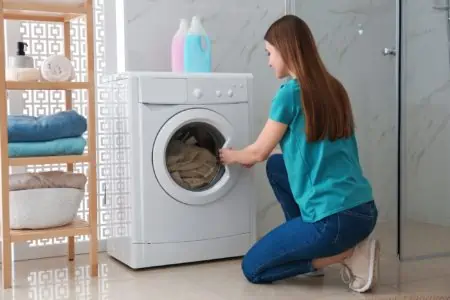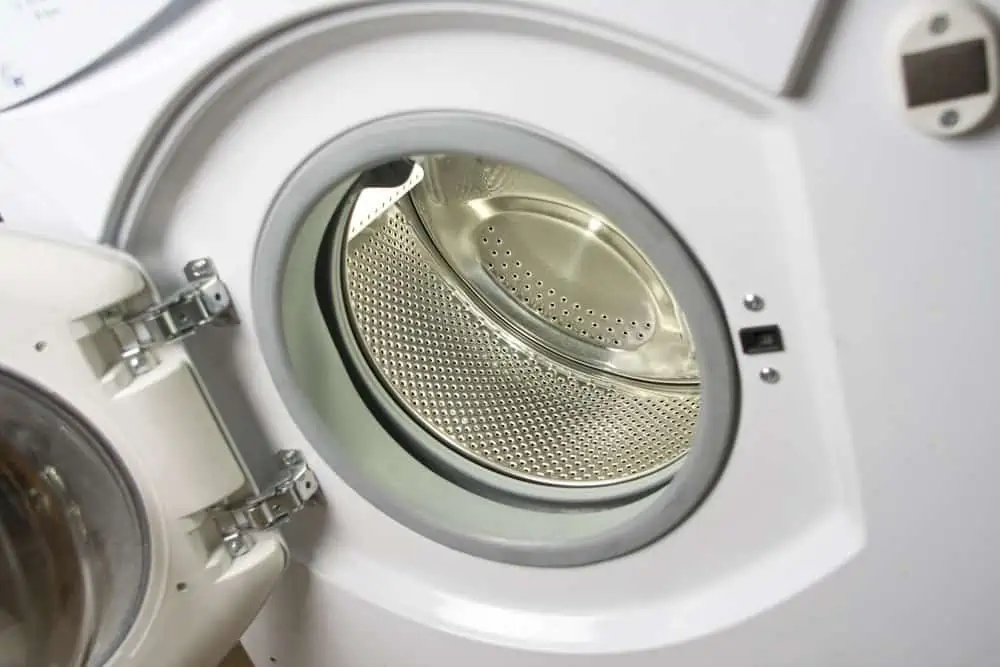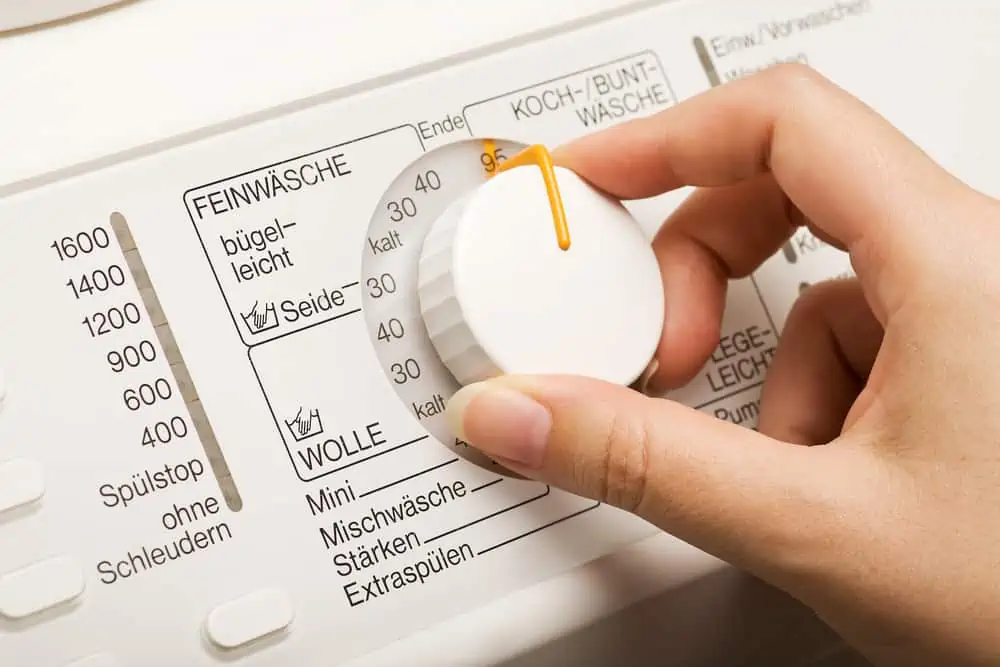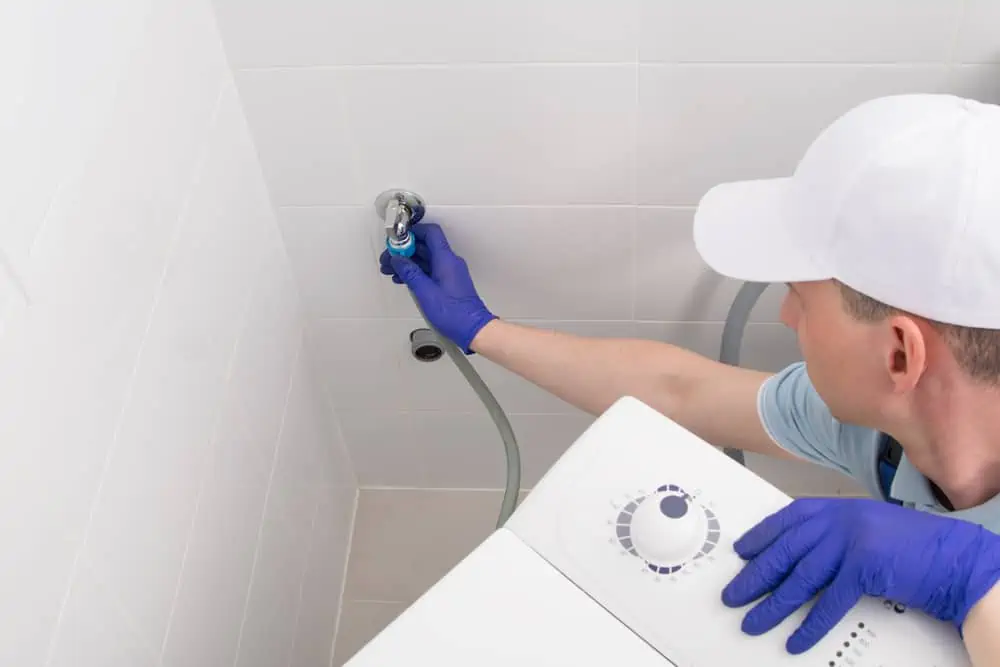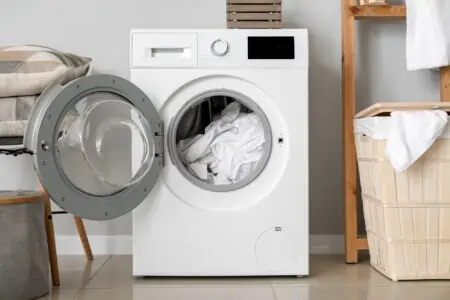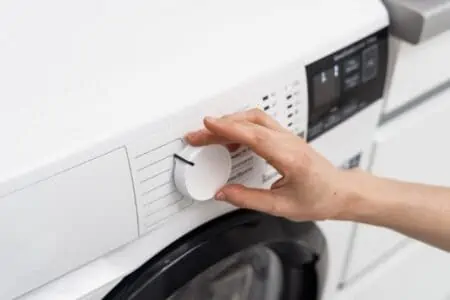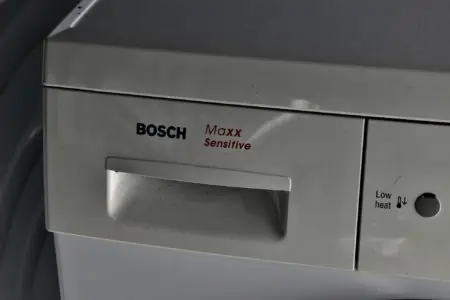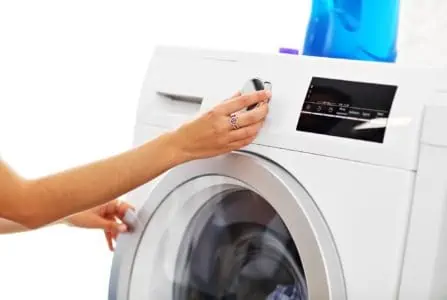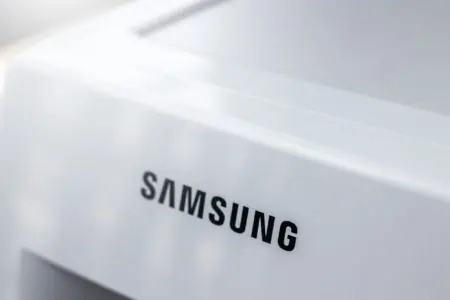We rely on technology day in, day out. One of the major appliances we value is the washing machine. It cleans our clothes, removes stains, and saves us a ton of time. But have you ever wondered how a washing machine works?
We’ll walk through the construction of a washing machine, how it all works, and whether it’s worth trying to fix a broken one.
By the end, you’ll be a walking washing machine whizz! Time to impress your friends and bask in your new found knowledge.
Key Takeaways
- Washing machines clean clothes using agitators, impellers, or rotating drums, depending on the type of machine (top load or front load).
- Front load washers are gentler on clothes, using gravity and rotational forces to clean them, while top load washers use agitators or pulsators to create friction.
- High-efficiency washers save water, energy, and detergent compared to regular washing machines, and come in both top and front-load varieties.
- Washing machines can have extra features such as silent mode, quick wash, eco-friendly mode, time delay, various wash cycles, self-cleaning, ability to add clothes during a wash, and built-in Wi-Fi.
Construction of a Washing Machine
To understand how a washing machine works, it’s important to get to grips with the main elements. We’ll break down the three main parts: inside the washer, the controls, and the machine’s plumbing system.
Inside the Washer
Have you ever looked at your washing machine and wondered, “What is actually going on in there?”
Well, the answer differs for front and top load machines. Let’s start with front load washers.
You don’t have agitators or pulsators in front loading machines. Instead, the drum spins. It uses gravity and rotational forces to move clothes through the soapy water inside the machine. Not only is this more gentle on your clothes, but this is also how it cleans them.
The drum moves back and forth, swishing the clothes around. They rub against each other and the drum itself to scrub out stains and dirt. After the cycle, the water is sucked away through a pump and emptied through a drain.
Top-loaders use agitators or pulsators. During the cycle, the agitator turns around, moving your clothes through the soapy water, but the drum doesn’t move. The agitator moves your clothes, so they scrub clean, either against the agitator, the other clothes, or the drum.
This movement creates friction, which is effective for cleaning but causes more wear and tear on your clothes over time.
Controls
When you put your clothes in the machine, you have the option to choose the cycle. On the control panel, you’ll find a range of different options. For instance, some appliances let you choose a cycle based on the type of clothes: cotton, synthetics, or wool. Other appliances give you the option to change the settings based on spin speeds and temperatures.
These controls work like a computer. The central processing unit sends a message to the machine based on your chosen settings. This tells the machine what to do based on your decision, ensuring that the appliance uses the preferred temperature and speeds.
This works by the controls signaling the motor. It tells it which hot and cold water amounts to supply during the cycles. For instance, if you select cold, only the cold water valve will open.
When you choose a speed setting, the plastic rocker in the machine engages two sets of contacts. This either opens or closes the circuits connected to those contacts.
Plumbing
The plumbing of a laundry machine determines a few things:
- The correct water temperature.
- During a wash cycle, the plumbing recirculates water from the bottom of the tub to the top.
- It pumps water into a drain during the spin cycle.
Most appliances have two water lines coming from the back: one for hot water, one for cold.
Before the water comes into the appliance, it is sent through an anti-siphon device which prevents dirty water from going back into the water supply lines.
Your machine also has an overflow port which prevents the machine from flooding and ruining your motor.
How Does a Washing Machine Work?
Let’s get into more depth and detail about the functions of a washing machine’s operation. We’ll go through different types of top loaders as well as front load washers, high-efficiency washers, automatic washers, and semi-automatic washers.
Top Load Washers
There are two types of top load washers: impeller washers and agitator washers.
You’ll find a control system and a mechanical system in both appliances. The control system includes the timer, temperature selector, load size selector, control boards, and lid locking switch. The mechanism system includes the pumps, water valve, transmission, clutch, wash tubs, suspension system, and a motor coupling.
Both fill with water which submerges the clothes. However, the difference is how the impeller or agitator washes the clothes.
With Impellers
An impeller is a shallow cone or disc that sits on the drum floor and works a bit more like front load washers do. The drum rotates around a horizontal axis and is more water-efficient. The machine will spin, using less water and detergent.
The impeller spins or rotates in place, which rubs clothes against each other. This friction works to clean the clothes. The impellers also have a spraying mechanism that adds fresh water to the clothes during the wash and rinse cycle.
With Agitators
Agitators are more common than impellers in top loading machines. It’s a central pillar in a machine that moves clothes around the water. This continues throughout the cycle to mix the detergent through the water and against the clothes. It also encourages the clothes to rub against one another in order to scrub out dirt and stains.
Some models use a two-part agitator. The top part of the agitator moves in one direction, which sends the laundry to the bottom of the tub. The lower part of the agitator then moves the laundry back up.
Like impellers, many agitators have a spraying action that tops up the cycle with fresh water. While agitators are very effective at cleaning clothes, they’re not very gentle and are more likely to damage fabrics.
Front Load Washers
Front load washers typically have six stages: filling, dispensing, washing, draining, rinsing, and finally, spinning.
Once you select the load type and temperature, the machine typically senses the load size to determine how much water to use. Once you shut the door and begin the cycle, the machine fills with water.
When the machine has filled with an adequate amount of water, the machine stops filling with water before dispensing the detergent and fabric softener during the proper stage of the cycle.
The machine carries on with its wash cycle. A front load washer cleans your clothes by rotating the drum in both directions. Some models use a drive motor, belt, and pulley to rotate the tub. The drum tumbles the clothes in one direction, pauses, then tumbles in the other direction.
This movement submerges and plunges the clothes into the water and detergent.
After the wash cycle, the machine pumps the water out of the drain hose into a pipe.
The rinse cycle works similarly to the wash cycle. This is when the fabric softener is dispensed into your cycle. The water drains again.
Then the machine spins. This is much faster than the wash cycle to remove all excess water from your clothes, so they aren’t dripping wet when the entire cycle is over. This reduces drying time.
High-Efficiency Washers
High-efficiency washing machines clean your clothes wonderfully while using less water, energy, and detergent than regular washing machines. You can find both top and front-load HE washers.
Since these machines use less water, you need a specialized HE detergent that produces less suds.
Once the lid locks, it senses the load size. The machine might spin for a few minutes without any water. This is so that the machine can determine the load size, an unbalanced load, and possibly even the fabric type.
Once the washer has determined the load type, it will fill with water before pausing to let the water soak the clothes. You’ll notice the machine spins and pauses a few times before the wash cycle commences.
The low water levels then clean the clothes. The wash plate or drum moves the clothes against each other to agitate dirt and stains. The clothes move all around the drum to ensure that they don’t remain static in one part of the drum. The machine will stop and start, pausing now and then. This continues throughout the wash cycle.
The water then drains from the drum before rinsing the clothes. The machine then spins fast to drain excess water from the clothes. When the machine is done, the door automatically unlocks.
Besides these differences, the operation is similar to that of the top or front-load machines. They are just more efficient, but they will use an agitator or tumbling effect depending on the type of washing machine you have.
Automatic Vs. Semi-Automatic
Both automatic and semi-automatic machines wash, rinse and dry your clothes.
It’s not a surprise that automatic machines do more of the work for you. A programmer tells each part of the washing machine what to do and for how long. It combines water and detergent and even dries your clothes after the cycle. You’ll find both top and front-load automatic washing machines.
Semi-automatic laundry machines, also known as twin tub machines, have two side-by-side tubs. One wash and one dries.
You need to put the water and laundry detergent into the machine yourself. After the cycle, you also need to transfer the wet clothes to the dryer tub. It’s a simpler appliance, and they are also cheaper than automatic machines.
Additional Washing Machine Features
Many washing machines include extra features besides washing, rinsing, and spinning your clothes. These features can make your washing experience easier and more effective. Let’s look at a few extra features and programs that you might find on a washing machine.
- Silent mode: Some brands, such as Grundig and LG, have a silent mode feature. This skips the spin cycle and ends the entire cycle before the final rinse. It then automatically resumes a few hours later so that the machine is extremely quiet while you’re nearby. Other brands have a lower spin speed, maxing at 1000 RPM so that the machine doesn’t make as much noise.
- Quick wash: Many washing machines have a quick wash cycle that cleans clothes in as little as 15 minutes. This works by spinning the clothes faster so that they wash and dry faster. Keep in mind that this is only for freshening up lightly soiled clothes. You should also fill it about halfway. It’s not for frequent large loads of laundry or laundry that is very dirty.
- Eco-friendly mode: Eco mode on your machine is usually an excellent choice for daily laundry. It is the most energy and water-efficient option. It uses low temperatures, less water, and less energy to wash your clothes adequately.
- Time delay: If you want your machine to go off at a specific time — for instance, to avoid being on when guests are round, or to start at five in the morning, so your wet clothes aren’t sitting in the machine all night — look for one with a time delay option.
- Various wash cycles: We like washing machines with a range of wash cycles. For instance, a hand wash or gentle cycle is a must-have. You’ll likely be washing delicate clothes such as lingerie, wool, or embroidered items. It’s vital that your washing machine can handle these garments as well as regular cotton or linen clothes.
- Self-cleaning: Many modern appliances have a self-cleaning option. You often don’t need to add any cleaning products (although we love to add one cup of distilled white vinegar). The machine will then perform a drum cleaning cycle for you.
- Add clothes during a wash: If you forget garments often, you will benefit from a machine that lets you add items during the wash cycle. Many old-fashioned top-loaders already let you do this. But front-load washers don’t allow this since the door locks. But new models often contain a miniature door that you can open and add a garment through.
- Built-in Wi-Fi: If you want to control your machine from anywhere, then look for one with built-in Wi-Fi. This is handy if you have put clothes in the machine but forgot to start it. Many apps also help you choose the cycle settings. For instance, you can tap all the items in the drum (t-shirts, underwear, and socks, for example), and it will choose the exact settings on which to wash them.
Is It Worth It to Fix a Washing Machine?
When something goes wrong with your machine, should you fix it or just buy a new one?
In our experience, washing machines are pretty complex to diagnose when there’s a problem. There are lots of different parts and elements. We’ve had excellent luck in contacting the machine manufacturer for help. They have always sent out a repair person who has fixed the issue under warranty.
If you know the issue, you can usually fix it yourself with a little help from YouTube or online guides. However, it usually helps if you have a bit of DIY experience!
Overall, you should always try to fix a laundry machine before replacing it. These appliances aren’t cheap, so if you can save a few hundred dollars fixing them, then that’s worth it.
However, if your machine is around the 10-year mark and failing you in all kinds of ways, it might be time for a new one.
FAQs
Washing Machine Anatomy
We hope you enjoyed this lesson in the physics and anatomy of washing machine’s . Now that you’ve dived deep into the ins and outs of these appliances, you know exactly how it operates.
Knowing this information can help you troubleshoot issues within your own appliance. It also might guide you towards the best type of machine for you: top loading, front loading, or high efficiency.
Overall, it gives you some bitesize knowledge and fun facts that might help you out at the next pub quiz!
